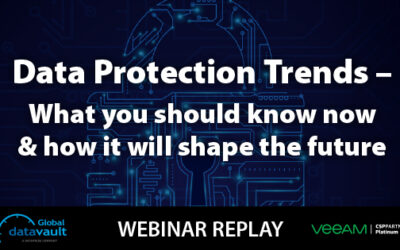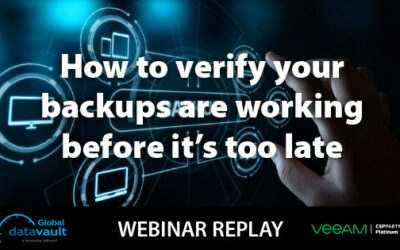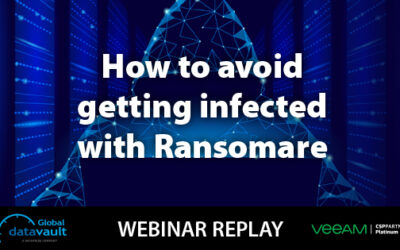Note: We’ve already queued up the next in the series, Do You Speak Veeam, Demystifying Veeam Vocabulary. If that sounds like something your team would benefit from, register now or come back here for the replay.
- What is Backup as a Service?
- What is Disaster Recovery as a Service
- How does BaaS work?
- What resources do you need for BaaS?
- How does Disaster Recovery as a Service work?
- What resource do you need for DRaaS?
- How is Global Data Vault different?
- What is the difference between Baas and DRaaS?

What is Backup as a Service?
Backup as a service, or BaaS, is an offering by which organizations utilize third-party offsite or cloud resources to store backup files. BaaS may refer to a service provider managing your on-premises backups for you but generally refers to offsite storage. BaaS allows you to recover data from any location and reduces the risk of data loss through a site failure, thereby meeting the requirements of the 3-2-1 backup rule.

What is Disaster Recovery as a Service?
Disaster recovery as a service, or DRaaS, takes the same principle of sending copies of data offsite but enables applications and workloads to be powered on in the event of a disaster or site failure. This works for individual workloads or entire data centers and uses cloud-based resources. DRaaS offers a lower RPO and RTO over BaaS.

How does BaaS work?
At a basic level, BaaS copies backups of data offsite. We use Veeam® Backup & Replication™ (VBR) for all BaaS-related activities. VBR takes local backups first, either at the hypervisor level (agentless, block-level, and image-based) or using agents in guest operating systems. We then use a backup copy job to transfer the data to our cloud-based infrastructure. From there, we can restore any item, virtual machine, or server for you.

What resources do you need for BaaS?
We always recommend a business impact analysis (BIA) as part of your business continuity/disaster recovery (BCDR) planning. A business impact analysis identifies the criticality of applications and systems to business operations and provides recovery guidance.
You will also need a system to run your backup software and store backup files and data on-premises. At a minimum, you need storage that is entirely separate from your production workload storage. Sufficient Internet/WAN bandwidth is necessary to transfer your data and local resources for any hands-on needs. Operating system and other software licensing responsibilities remain with you, but we can help with Veeam licensing if needed.

How does disaster recovery work?
With Veeam, DRaaS functions in one of two ways, or both. Using similar methods as BaaS, backup copy jobs send backup files to the cloud provider. DRaaS allows recovery of those systems by connecting the backup files to a hypervisor, such as VMware or Hyper-V, and powering them on without restoring them first. VBR also has built-in replication to create fully hydrated virtual machines (powered off) awaiting a power-on command. Both methods follow recovery time- (RTO) and recovery point objectives (RPO), while replication sees lower RTOs and RPOs.
At Global Data Vault, we recreate your network in our cloud environment and recover machines in the order specified. As a DRaaS provider, we handle the heavy lifting of recovery for you.

Resources you need for disaster recovery
BIAs and BCDR plans are crucial for successful disaster recovery. DR failovers involve networks and much more complicated configurations than BaaS due to the nature of running systems, workloads, and applications from cloud resources.
DR resources at the end-user/on-premises level are no different than resources required for BaaS. For cloud providers, we must have resources available to run applications, workloads, and systems, which may include hypervisors and storage. We also need the ability to handle additional network traffic, provide sufficient security, and back up systems running in our infrastructure. When you are ready for a failback, we send the data back to you and bring the workloads up in your data center.

How is GDV different than the competition?
Some DRaaS providers only give you a “user guide” of sorts, leaving you in the dark during disaster recovery events. The Veeam experts at Global Data Vault handle most, if not all, of the disaster recovery process, allowing end-users to focus on more localized tasks. During disasters, employees may have crises of their own, have no power or access to systems, and cannot assist in a typical manner.
GDV includes an annual, hands-on DR test at no additional cost to ensure systems work appropriately during a disaster. Testing allows GDV and end-users to validate all systems, check documentation and process accuracy, and satisfy DR test and audit requirements businesses may have.

What is the Difference between BaaS and DRaaS?
The main difference between BaaS and DRaaS is the ability to resume operations quickly. While both utilize budget-friendly OpEx models, only DRaaS gives you the ability to run workloads in a cloud environment without restoring entire systems first. Disaster recovery as a service encapsulates networks to allow communication between applications and services and deliver functionality to end-users and customers when a primary data center or facility is down.
DRaaS offers lower RTOs and RPOs and, considering the minimal cost difference at GDV, DRaaS is a better solution. As our friend Jason Buffington (@jbuff) says, “Why BaaS when you can DRaaS?”
More Cybersecurity Webinars
Webinar: Data Protection Trends 2022
Our March webinar featured special guest, Jason Buffington, Vice President of Solution Strategy for Veeam® Software, and author of the comprehensive industry report: Data Protection Trends 2022. With webinar host, Kelly Culwell, Global Data Vault, Jason took a deep...
Webinar: How to verify backups are working?
Global Data Vault’s February 2022 webinar again takes us "back to the basics" with an important topic: how to verify if your backups are working. Not to spoil the movie ending here, but the common theme in the video below is the need to test, monitor, and test again....
How to Avoid Ransomware Webinar
Global Data Vault's January webinar takes us back to the basics with a topic that's actually anything but basic--ransomware and how to avoid it. Today, we're sharing our recent client experiences with ransomware, how these companies knew they were attacked, what the...
Webinar: Cybersecurity Budget Breakdowns
When it comes to cybersecurity, every organization is constrained and confined by some sort of budget. This webinar, hosted by BitLyft Cybersecurity, brings together a cybersecurity professional and an IT veteran to discuss the challenges and opportunities of finding...




0 Comments